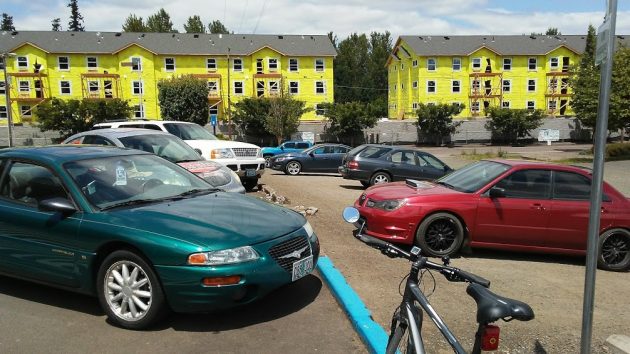
The “Sunset Village” apartments under construction in N. Albany: 40 units on 2.5 acres.
The legislature wants Albany and other Oregon cities to allow more housing, and different kinds of housing, to be built in the space available, which makes sense. But instead of easing up on Oregon’s insanely convoluted land-use laws, it has added new complications with House Bill 2001.
On Wednesday the bill was still awaiting the governor’s signature. When she signs it, it will become effective right away. And starting Jan.1, 2020, it will require cities the size of Albany to allow “middle housing” on all residential lots. Middle housing includes anything up to quadplexes, rowhouses and so-called “cottage clusters,” which are four or more detached units per acre of up to 900 square feet each arranged around a common courtyard. In England they might be called “mews.”
The bill gives cities of 25,000 or more until June 30, 2022, to change their compehensive plans and development codes. But it’s not clear whether property owners can insist on building middle housing on single-family lots before those changes are enacted. The bill fails to say. Instead, it subjects cities to the time-consuming and expensive process of changing their plans and codes.
Also not clear, at least to me, is whether middle housing can be built in the various residential subdivisions approved in the last few years but not yet built-up with single-family houses. If the developers want to change their plans now by building middle housing, do they have to go through a new approval process? You’d think legislators could have made that clear.
The bill allows cities “to regulate the siting and design of middle housing.” But the rules must not, “individually or cumulatively, discourage the development of all middle housing types permitted in the area through unreasonable costs or delay.” What’s an unreasonable cost or delay, and when is an added cost or delay reasonable? The bill doesn’t say, leaving plenty of room for arguments in court.
Albany, meanwhile, is adding housing capacity and increasing density without being told. In the last year alone, the planning division has reviewed four apartment projects with more than 400 units, the latest being the 105-unit “The Banks” development near Bowman Park. Also on the list: 147 units across the street from the new Meadow Ridge School, 64 units off Queen Avenue, and 96 units off southeast Waverly Drive.
That’s in addition to the 48 units of “Hickory Hollow” in North Albany completed last year, the 40-unit “Sunset Village” farther east on Hickory Street now being finished, and the 132 new apartments at Knox Butte Road and Timber Street.
More “middle housing,” if it happens, will be helpful to people who can’t afford a single house and don’t want an apartment. We’ll have to see whether HB 2001 actually brings it about. (hh)

Pack ’em in like sardines. No mention of quality of life. Would really like to know what’s fueling this crush. Are we really a bedroom community for portland and eugene?
Albany’s population growth is “fueling” it. We’re not a bedroom community for EUG or PDX, but we have been for one for Corvallis for many years…
Spot on! And so has Lebanon. Just ask Hwy 34.
Population growth doesn’t tell me much. From procreation? From migration? If migration what is it we have? Jobs? What jobs? What is bringing people here at this phenomenal rate? I’d love to know.
Albany is growing pretty much as has been predicted each year… And, it’s cheaper to live here than larger metro areas. That, plus jobs are plentiful – especially if you have skills.
Maybe what the legislature wants “makes sense” as Hasso puts it, but why should we even have to be interested about it? What business is it of the state to rule about private land use in the first place. It smells like Stalin’s “land reform.” If we do like regulations, local ones should surely suffice.
Another perspective on the issue:
https://youtu.be/Ke4Dn6KlXCU
In addition to serving unmet needs for housing diversity, higher density can be a community asset if done right. Here’s an attractive type of cottage cluster with about double the density of typical single-family houses:
https://en.wikipedia.org/wiki/Pocket_neighborhood
Links to slideshows of some examples:
https://rosschapin.com/projects/pocket-neighborhoods/
“Design Patterns for Pocket Neighborhoods” by the same architect. Click through the 15 patterns:
https://pocket-neighborhoods.net/designpatterns.html
The neighborhoods look nice but over $700,000.00 resale price for under 900 square feet of condo? Investors seem to be the real winners with the resale price up 250 %?
How did you arrive at “over $700,000.00?” I assume you mean the “Third Street Cottages” in Langley, WA, because that’s the only search result on either website containing “250%” or similar wording. Please say if you have another source.
Zillow shows two sales at $390,000 in August, 2018. Those were 720 and 600 sq.ft.
“””In the years since completion of the neighborhood in 1998, some cottages have resold with price tags of as much as 250 percent of their original price,
proving their enduring value.”””
https://pocket-neighborhoods.net/ExcerptChapter6.pdf
The houses were built in 1998 and the book was published in 2011. Notice that it’s 250% OF the original price, not UP 250% (implying 350% OF). None of these numbers are much out of line with comparables in Langley.
In Beaverton they are going to build 54 apartments for 20.9 million dollars, this is considered affordable housing? 20.9 million dollars would build a lot of mobile homes from our local manufactures. You could have child care, pools, buses and all kind of community specific services for 20.9 million. C’mon Man!